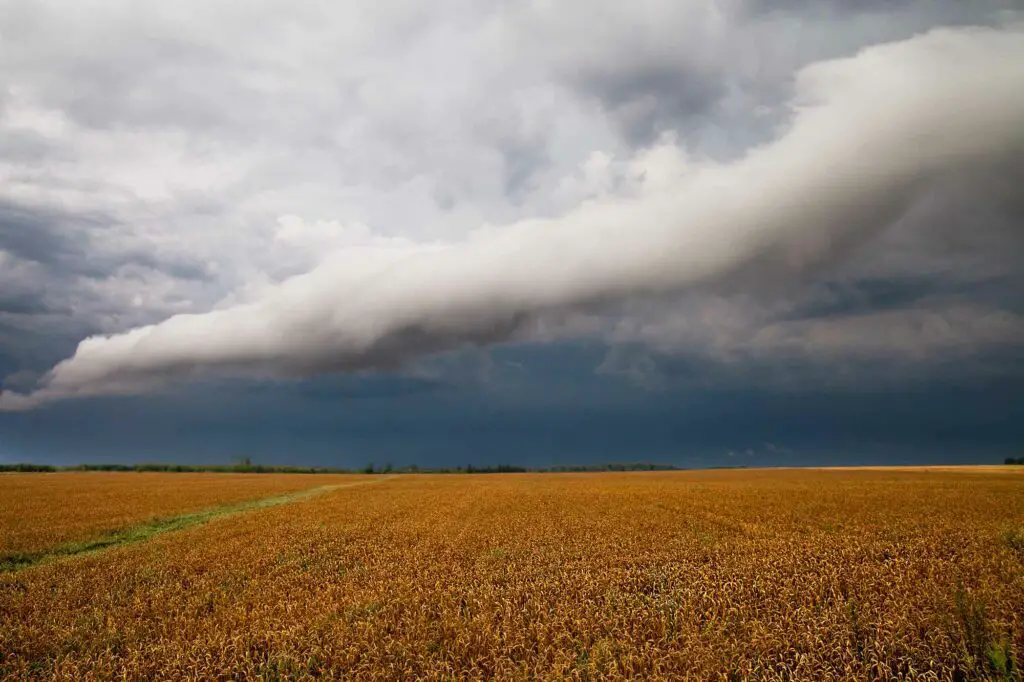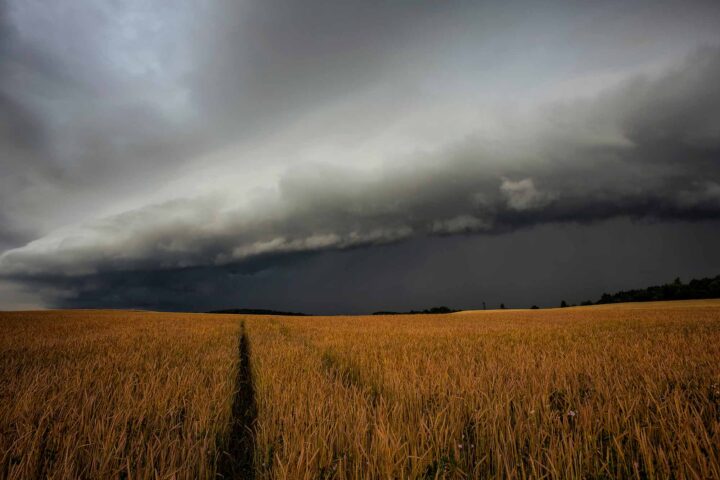Eine Ausflussgrenze ist ein meteorologischer Begriff, der sich auf die Grenze zwischen zwei Luftmassen die durch den Abwind eines Gewitters entsteht. Wenn Sie schon einmal während eines Gewitters draußen gestanden und den kühlen Luftzug vor einem Gewitter gespürt haben, haben Sie eine Abflussgrenze erlebt.
Ausströmungsgrenzen sind nicht nur für diese Sturmböen verantwortlich und können neue Stürme auslösen, insbesondere wenn die Ausströmungsgrenzen anderer Stürme aufeinander treffen.
Was ist eine Abflussgrenze?
Eine Ausströmungsgrenze ist ein meteorologisches Merkmal, das sich bildet, wenn kalte Luft aus dem Sturm nach unten und nach außen strömt (Abwind) und die warme Luft um sich herum anhebt. Diese Ausströmung erfolgt zwar in alle Richtungen, aber die Strömung ist am stärksten in der Richtung, in der die Winde in den unteren Schichten nahe der Oberfläche wehen.
Eine Ausflussgrenze ist in der Nähe ihres Ursprungspunkts am stärksten und löst sich auf, wenn sie sich nach außen ausdehnt. Dies geschieht nicht sofort; Manche Grenzen können sich über Hunderte von Kilometern erstrecken. Sie sind oft als Regal oder Rolle auf dem Boden sichtbar Wolken und auf dem Radar als dünne Linie schwacher Renditen. Unten haben wir ein Beispiel einer Abflussgrenze auf dem Radar gezeigt.
Wie entstehen die Abflussgrenzen?
Ausströmungsgrenzen bilden sich, wenn kalte Luft aus einem Gewitterabwind unter die wärmere Luft vor dem Gewitter drückt. Die dichte, kalte Luft, die mit Ausströmungsgrenzen verbunden ist, kann die Temperaturen schnell senken und starke Winde erzeugen.
Diese Grenze ist manchmal als eine Linie von Kumuluswolken an der Vorderkante eines Gewitters zu sehen (auch Schelf- oder Rollwolken genannt). Sie ist auf dem Radar oft deutlich sichtbar, insbesondere im "Velocity"-Modus, verursacht durch Käfer, Staub und andere Trümmer, die durch den plötzlichen Windstoß am Rande der Abflussgrenze in die Luft geblasen werden.
Ausströmungsgrenzen werden manchmal mit der Entwicklung von Wolken und Stürmen in Verbindung gebracht. Wenn diese Grenzen mit warmer, feuchter Luft und untereinander interagieren, können sie dazu beitragen, neue Wolken und Stürme auszulösen. Auf dem Radar lässt sich die Richtung einer Ausströmungsgrenze daran erkennen, in welche Richtung sie sich biegt.
Wenn die Ausläufer zweier Stürme an einem warmen, feuchten Tag aufeinander zusteuern, würde ein Meteorologe erwarten, dass sich dort, wo diese Grenzen zusammenstoßen, wahrscheinlich ein neuer Schauer oder Sturm bildet.
Abflussgrenzen und Unwetter
Abflussgrenzen werden auch Böe genannt Vorderseiten, für die plötzlichen Böen, oft mit Böen von 30-50 Meilen pro Stunde. Diese Winde sind zwar nicht unbedingt schädlich, können aber leicht leichte Gegenstände, die nicht am Boden befestigt sind, aufheben und wegschleudern.
In seltenen Fällen kann der für die Abflussgrenze verantwortliche Abwind extrem stark sein microburst. Ein Mikroburst ist ein starker Abwind von Luft, der Windgeschwindigkeiten von über 100 Meilen pro Stunde erzeugen kann. Mikrobursts werden häufig mit Unwettern in Verbindung gebracht, z Wirbelstürme und Gewitterstürme. Geschieht dies großflächig, spricht man von einem Makroburst. Während beides seltene Ereignisse sind, kommen Mikrobursts weitaus häufiger vor.
Über Wüstengebieten können Abflussgrenzen "Haboobs" auslösen, Staubstürme, die durch Gewitterwinde ausgelöst werden.

Tipps für die Sicherheit bei Unwettern
Schwere Unwetter können eine Gefahr für Leben und Eigentum darstellen. Es gibt jedoch einige Maßnahmen, die Sie ergreifen können, um bei Unwettern sicher zu sein.
Eines der wichtigsten Dinge ist, sich über die aktuellen Wetterbedingungen zu informieren. Sie können dies tun, indem Sie die lokalen Nachrichten verfolgen und die Nationaler Wetterdienst in den sozialen Medien. Es ist auch wichtig, zu planen, was im Falle eines Unwetters zu tun ist. Dazu gehört, dass Sie einen sicheren Raum in Ihrem Haus haben und die beste Evakuierungsroute kennen, falls dies notwendig ist.
Darüber hinaus ist es wichtig, eine Notfallausrüstung mit Lebensmitteln, Wasser und Erste-Hilfe-Materialien bereitzuhalten. Wenn Sie diese Vorkehrungen treffen, können Sie Ihre Sicherheit bei Unwetterereignissen gewährleisten.



